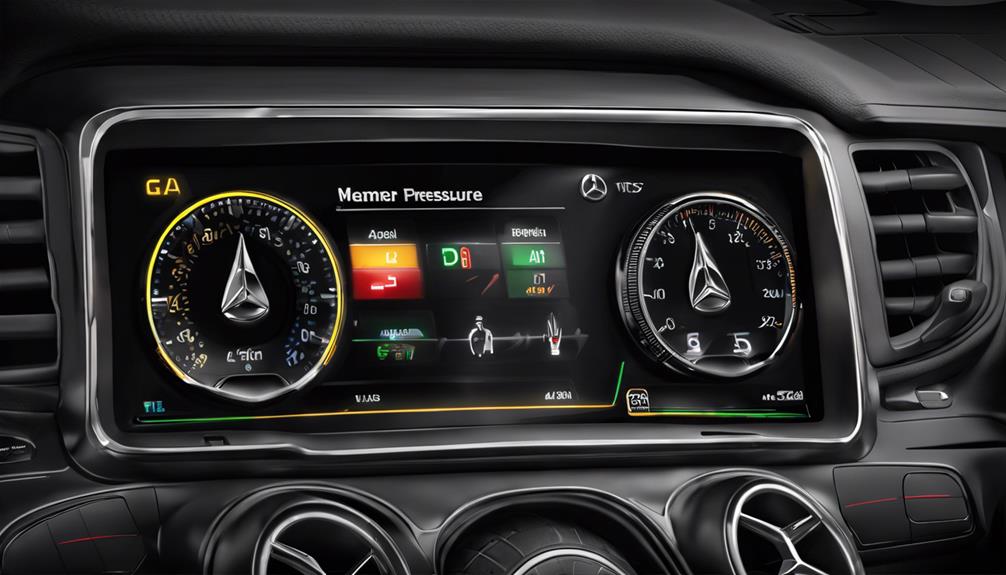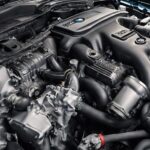If you own a Mercedes GLB 250, watch out for the TPMS light indicating low pressure or slow leaks, and pay attention to vital warnings from the dashboard lights to avoid higher repair costs. Guarantee proper tire pressure for fuel efficiency. Don't overlook the importance of the Fog Lights Indicator enhancing visibility in challenging weather or the Lane-Keeping Assist Functionality for stability on the road. Issues like Automatic Shift Lock and ABS warning signs should be promptly addressed to maintain safety. Stay informed about common engine problems as regular maintenance is key to longevity. Learning more about these aspects can assist you in managing potential issues effectively.
Key Takeaways
- TPMS and dashboard warning lights for tire pressure and crucial alerts.
- Fog lights indicator and lane-keeping assist for visibility and stability.
- Automatic shift lock safety feature and ABS warning signs for brake issues.
- Engine reliability concerns and maintenance tips for GLB 250 longevity.
- Stay informed on common engine issues to prevent potential problems.
Tire Pressure Monitoring System (TPMS) Light

When the TPMS light illuminates in your Mercedes GLB 250, immediate attention is crucial to address potential tire pressure issues efficiently. This new warning light serves as an essential indicator of tire health, signaling low pressure or slow leaks that could impact your driving experience.
Monitoring this warning light is vital, as it allows you to proactively manage your tire maintenance, ensuring peak performance and safety on the road.
Incorporating a proactive approach to addressing TPMS alerts not only extends the lifespan of your tires but also enhances fuel efficiency in your Mercedes GLB 250. Proper tire pressure management, guided by the TPMS light, plays a significant role in maintaining driving stability and optimizing traction control.
Dashboard Warning Lights Confusion
When driving your Mercedes GLB 250, understanding the meanings of dashboard warning lights is essential to identify and address potential issues promptly.
These warning lights serve as your vehicle's communication system, alerting you to malfunctions or critical maintenance needs.
Ignoring or misinterpreting these warnings can result in more significant problems and higher repair costs down the road.
Warning Light Meanings
Understanding the meanings of dashboard warning lights on your Mercedes GLB 250 is crucial for maintaining vehicle safety and performance. The check engine light indicates issues with the engine or emissions system, necessitating prompt attention. The monitoring system light signifies a fault in the vehicle's monitoring systems, requiring a diagnostic check. Familiarizing yourself with these symbols can prevent potential problems and ensure your Mercedes GLB 250 operates at its best. Below is a table outlining the meanings of some common dashboard warning lights:
| Warning Light | Meaning |
|---|---|
| Check Engine Light | Engine or emissions system issue |
| Monitoring System | Fault in vehicle monitoring systems |
| Tire Pressure | Low tire pressure alert |
| Fog Lights Indicator | Fog light activation |
| Headlight Indicator | High beam or low beam headlight usage |
Troubleshooting Dashboard Alerts
To effectively troubleshoot dashboard alerts related to confusing warning lights, familiarize yourself with the specific symbols and meanings to pinpoint potential issues swiftly. Understanding these indicators can help you identify critical problems with your Mercedes GLB 250, such as issues with the engine or other essential systems.
For instance, the check engine light signifies a problem with the engine that requires immediate attention. If you see a warning light related to the braking system, it could indicate low brake fluid or a malfunction. By recognizing these signals promptly and taking appropriate action, you can guarantee the longevity and performance of your vehicle.
Stay informed about these dashboard alerts to drive safely and maintain your car's systems effectively.
Understanding Fog Lights Indicator

The indicator for the Fog Lights on your Mercedes GLB 250 serves as an important tool in distinguishing between different lighting functions for best visibility. When understanding the Fog Lights indicator, consider the following:
- Alert System: The indicator alerts you when the fog lights are activated, ensuring you're aware of their status.
- Differentiation: It helps differentiate between the headlights and fog lights, enabling you to use the appropriate lighting for specific conditions.
- Enhanced Visibility: By knowing when the fog lights are in use, you can enhance visibility during challenging weather like fog or heavy rain.
- Optimized Effectiveness: Familiarizing yourself with how the fog lights indicator works optimizes their effectiveness in low-visibility situations, benefiting both you and other road users.
Understanding the Fog Lights indicator can substantially improve your driving experience by ensuring you have the right visibility tools at your disposal when needed.
Lane-Keeping Assist Functionality
When operating your Mercedes GLB 250, the Lane-Keeping Assist feature actively monitors lane positioning to enhance driving stability and safety.
This driver assistance system employs cameras and sensors to track lane markings, providing corrective steering inputs when necessary to help keep your vehicle centered within the lane.
If you unintentionally drift out of your lane without signaling, Lane-Keeping Assist can issue visual, audible, or haptic alerts to prompt you to take corrective action.
It's important to note that while this feature is designed to enhance safety, it's essential to remain engaged and keep your hands on the steering wheel at all times.
Additionally, the system can typically be adjusted or turned off to suit your preferences or adapt to specific driving conditions. By functioning correctly, Lane-Keeping Assist contributes significantly to reducing the likelihood of unintended lane departures, promoting a safer driving experience for you and your passengers.
Automatic Shift Lock Operation

Facilitate seamless gear changes by intuitively activating the Automatic Shift Lock feature when driving your Mercedes GLB 250. This function plays an important role in ensuring safe and efficient gear selection processes. Here are some key points to keep in mind:
- Brake Requirement: The Automatic Shift Lock warning serves as a reminder to press the brake pedal before shifting into Drive. This step is essential to prevent accidental gear changes and maintain control over the vehicle.
- Preventing Inadvertent Shifting: By engaging the Automatic Shift Lock, you reduce the risk of mistakenly shifting into gears that could compromise safety or vehicle operation. This feature helps reinforce the correct sequence for gear selection.
- Enhanced Safety: Understanding and utilizing the Automatic Shift Lock function enhances overall driving safety by promoting attentive and deliberate gear changes. It adds an extra layer of protection against potential errors.
- Driving Experience: Familiarizing yourself with the Automatic Shift Lock operation not only ensures safety but also contributes to a smoother and more enjoyable driving experience. Proper use of this feature can make your time behind the wheel more comfortable and stress-free.
Traction Control Malfunctions
Experiencing malfunctions in your Mercedes GLB 250's Traction Control system can greatly impact your vehicle's stability on various road surfaces. The Traction Control light serves as a key indicator of the system engaging to prevent wheel spinning, especially important for maintaining stability on slippery terrains.
When this system malfunctions, it can compromise your driving safety and control by potentially reducing stability and handling capabilities. Promptly recognizing signs of Traction Control issues is essential to guarantee timely auto repairs.
Failure to address these malfunctions promptly can lead to further complications and potential safety hazards while driving. Hence, if you notice any irregularities with your Traction Control system, such as the light staying illuminated or unusual handling behavior, it's recommended to seek professional auto repair services to diagnose and rectify the problem efficiently.
Maintaining the proper functioning of your Traction Control system is crucial for a safe and stable driving experience.
ABS Warning Signs

To identify potential issues with the Anti-Lock Braking System in your Mercedes GLB 250, paying attention to the ABS Warning light is essential for maintaining top vehicle safety and braking performance. Here are four signs related to the ABS Warning light you should be aware of:
- Illumination of the ABS Warning Light: If the ABS Warning light on your dashboard stays lit or flashes during driving, it indicates a problem with the Anti-Lock Braking System that requires attention.
- Strange Brake Pedal Behavior: If you experience unusual pulsations, vibrations, or a spongy feel in the brake pedal when applying brakes, it could be linked to ABS issues.
- ABS System Noise: Unusual noises such as grinding or buzzing coming from the ABS system during braking can signify potential malfunctions that need to be addressed promptly.
- Reduced Braking Performance: Any decrease in braking efficiency, longer stopping distances, or brakes locking up unexpectedly can all point towards ABS system problems affecting your braking performance.
Addressing these ABS Warning signs promptly with professional diagnosis and repair is essential for ensuring your Mercedes GLB 250 maintains top braking functionality and keeps you safe on the road.
Common GLB 250 Engine Issues
If you notice any unusual engine performance in your Mercedes GLB 250, it could potentially stem from common issues known to affect its engine reliability. Mercedes-Benz engines, particularly the four-cylinders, have raised concerns regarding their dependability.
The 3.0L inline 6 engine, often found in certain models, has been cautioned against due to associated 48V system problems. In contrast, the 4.0L V8 engine, when not equipped with the 48V system, appears to be more reliable in specific applications.
Overall, four-cylinder engines lack a robust reputation for reliability within the Mercedes-Benz lineup. Being mindful of these tendencies when encountering engine-related issues in your GLB 250 is crucial.
Regular maintenance and prompt attention to any irregularities can help mitigate potential problems and maintain the longevity of your vehicle's engine. Stay informed about common engine issues to make informed decisions regarding the care and maintenance of your Mercedes GLB 250.
Frequently Asked Questions
What Is the Issue With GLB 250?
Facing issues with your GLB 250? The check engine light, paint imperfections, and headlight malfunctions are common. Touch screen glitches, headlamp moisture, and service worries persist. Technical faults like system blackouts and early engine troubles affect performance, warranting attention.
Is the Mercedes GLB Engine Reliable?
Yes, the Mercedes GLB engine can be reliable. Mercedes-Benz engines, like the 3.0 inline six-cylinder and 4.0L V8, are known for their reliability. However, four-cylinder engines in Mercedes vehicles might not have the same reputation for dependability.
What Should I Pay for a Mercedes Glb?
You should expect to pay around $38,050 for a Mercedes GLB 250. This price may vary based on additional features or packages. Consider factors like reliability, comfort, and ratings when evaluating if this cost aligns with your expectations.
What Is the Mercedes GLB 250 Comparable To?
When looking at the Mercedes GLB 250, you'll find it comparable to the BMW X1, Audi Q3, and Volvo XC40 in the compact luxury SUV segment. Its blend of performance, comfort, and technology mirrors its rivals, offering a well-rounded driving experience.
Conclusion
Overall, the Mercedes GLB 250 may experience common issues such as TPMS light alerts, confusion with dashboard warning lights, and malfunctioning traction control.
It's important to stay informed on these potential problems and address them promptly to guarantee the smooth operation of your vehicle.
By understanding these common issues and taking proactive measures, you can maintain the performance and safety of your Mercedes GLB 250 for years to come.









